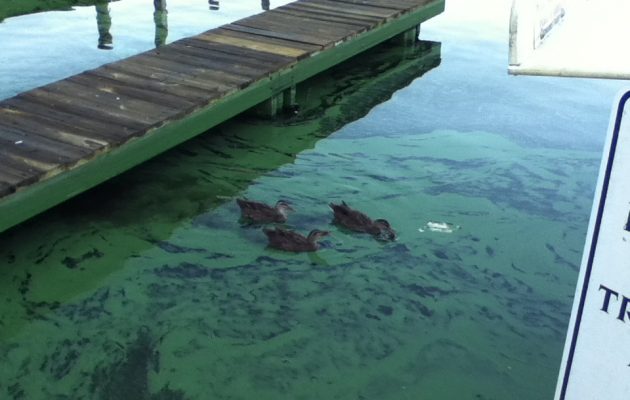Health official remind residents to avoid “green slime” in rivers
Posted on October 16, 2013 By Editor Articles, Neighborhood News, Top Stories

High levels of algal toxins found in St. Johns River
On October 7, 2013, St. Johns Riverkeeper took two algae samples from the St. Johns River to GreenWater Laboratories in Palatka for analysis. The test results detected total microcystin toxin levels at 1085 and 2080 micrograms per liter, or more than 50 and 100 times higher than the recommended recreational exposure threshold of 20 micrograms per liter from the World Health Organization (WHO).
“Based on the algae concentrations in the samples, this is probably indicative of a worst-case scenario,” states Lisa Rinaman, the St. Johns Riverkeeper. “However, the results demonstrate the high levels of dangerous toxins that some of these blooms can produce. It also demonstrates the urgent need to adopt tough numeric standards to limit the amount of nutrient pollution going into our river. Until we do, our river will continue to be sick and the health of our families will continue to be at risk from exposure to algal blooms and toxins.”
On October 16, the Florida Department of Health in Duval County (DOH-Duval) released a statement reminding individuals to avoid exposure to algal blooms in the St. Johns River and other water bodies in Florida.
Rinaman said she was happy to see the Department of Health send out that notice. “We have done some additional sampling but don’t have the results yet,” she said. “I’m anxious to see the results from the Water Management District.”
Blue-green algae are a group of organisms that can live in freshwater, salt-water or in mixed “brackish” water and may commonly be referred to as pond scum. They also are referred to as cyanobacteria. Most blue-green algae do not produce chemicals harmful to humans or animals, however, some types make natural substances called cyanotoxins. Over time, these toxins are diluted and eventually break down and disappear.
“Toxins can exist in the algae. Stay clear of any of the green slime,” said Rinaman. “We have been saying this all along. Don’t stay away from the river but stay away from the green algae. Report it to us if you see it so we can monitor the spread.”
You can send photos of algal blooms to [email protected], or via the website, or Facebook.
The Riverkeeper’s Oct. 7 water samples were taken from a heavy surficial accumulation of algae from the shoreline at Jacksonville University. Exposure to algal toxins can cause adverse health effects in humans and animals, including skin irritation, flu-like stomach ailments, hay fever-like symptoms, itchy eyes, asthma, and liver damage.
Precautions should always be taken to limit or avoid contact with algal blooms and algal toxins. Do not drink, cook, or bathe with untreated water from lakes, ponds, or rivers. Do not allow pets or livestock to swim in or drink scummy water. If you, your children or your animals accidently come in contact with an algal bloom, wash with fresh water and soap after skin contact and avoid swallowing or inhaling water. Wash your animals thoroughly before they start to groom themselves. People with liver problems (such as cirrhosis or hepatitis) may be at increased risk of harm from these toxins. Learn more at http://greenwaterlab.com/algal-toxins.html or for additional information on health issues related to algae visit, http://www.floridahealth.gov/healthy-environments/aquatic-toxins/cyanobacteria.html.




 (No Ratings Yet)
(No Ratings Yet)




